This article was co-authored by Jonathan Frank, MD. Dr. Jonathan Frank is an Orthopedic Surgeon based in Beverly Hills, California, specializing in sports medicine and joint preservation. Dr. Frank's practice focuses on minimally invasive, arthroscopic surgery of the knee, shoulder, hip, and elbow. Dr. Frank holds an MD from the University of California, Los Angeles School of Medicine. He completed an orthopedic residency at Rush University Medical Center in Chicago and a fellowship in Orthopedic Sports Medicine and Hip Preservation at the Steadman Clinic in Vail, Colorado. He is a staff team physician for the US Ski and Snowboard Team. Dr. Frank is currently a scientific reviewer for top peer-reviewed scientific journals, and his research has been presented at regional, national, and international orthopedic conferences, winning several awards including the prestigious Mark Coventry and William A Grana awards.
This article has been viewed 56,798 times.
Knee flexion is the degree to which you can bend your knee. Knowing your knee flexion limit can help you to assess your range of motion, which may be helpful if you’re recovering from an injury or surgery.[1] You can assess your knee flexion and extension at home using a goniometer or a phone app meant to simulate a goniometer. If you don’t have either of these tools, you can also estimate your knee flexion and extension using your fingers and a measuring tape.
Steps
Using a Goniometer
-
1Lie on your back on a firm surface. Find a carpeted patch of floor to lie down on, or place a yoga mat on a hard floor before you lie down. You could also place a folded blanket or a couple of towels on the floor and lie down there.[2]
- Avoid lying on a bed or sofa as these will not be firm enough to keep your body aligned.
-
2Align the goniometer or phone app against your leg. Ensure that the circular disc at the center of the goniometer is against the side of your knee. Position the stationary arm of the goniometer along your outer thigh so it’s in line with your greater trochanter, or the bone at the end of your femur that connects to your hip. Position the other arm of the goniometer with the lateral malleolus, which is the protrusion on the outside of your ankle.[3]
- Goniometers can be easily purchased on Amazon, and are essentially two rollers joined end to end.[4]
- You may find it easier to have a friend do this for you.
- If you’re using a phone app, check the app’s instructions for how to use it first. Phone apps work by identifying the angle of your phone when held against your thigh and then against your calf, so you’ll be instructed to position it along your thigh first and then along your calf.
Tip: Goniometer phone apps are available for free in the app store for your device. The accuracy of these apps is comparable to an actual goniometer.[5]
Advertisement -
3Straighten your leg out so the back of your knee is against the floor. Start by checking to see if you can extend your knee. Straighten out your leg so the back of your knee is against the floor or as close as you can comfortably get it to the floor. Check the goniometer or phone app’s angle to see your reading. Then, repeat for the other knee.[6]
- If your knee is fully extended, the goniometer will be at 0 degrees.
- Your knee is hyperextended if it’s -5 degrees or lower, and it’s under-extended if it’s 5 degrees or more.
-
4Bend your knee and slide your foot up close to your buttocks. Keep going until you reach the maximum point of your knee flexion abilities. Look at the reading on the goniometer or phone app to see what angle your knee can flex to. Then, repeat the measurement on your other knee.[7]
- Keep in mind that normal knee flexion varies depending on the medical organization. For example, the American Academy of Orthopedic Surgeons defines normal knee flexion as 141 degrees plus or minus 5.3 degrees, while the American Medical Association defines it as 150 degrees.
- Loss of flexion over time is usually due to arthritis in the knees, which causes there to be a loss of space between the thigh and shin bones.[8]
Estimating Range of Motion
-
1Lie on your back with your legs out straight. You can either lay on a carpeted floor or place a yoga mat or folded towel or blanket on a patch of hard floor before you lay down. However, don’t use a bed or sofa to do this as they are not firm enough to keep your body in a straight line.[9]
- You can also sit up with your legs stretched out in front of you if you prefer.
-
2Slide your fingers under your knee to check the degree of its extension. Place your palm flat on the ground beside your knee and then try to slide your fingers under your knee starting with your index finger. Keep your knee pressed as flat against the ground as possible as you do this. Use the number of fingers you can fit under your knee to determine the approximate angle of your knee when it’s extended. The approximate angles are as follows:[10]
- 2 fingers: 0 degrees
- 4 fingers: 5 degrees
- Whole hand: 10 degrees
- Can’t get any fingers under your knee: -5 degrees or hyperextension
-
3Bend your knee and slide your foot up towards your buttocks. To estimate the flexion of your knee, bend it as far as it will go comfortably while keeping your foot flat on the ground. Inch your heel closer and closer to your buttocks until it won’t go any further.[11]
-
4Measure the distance from your buttocks to your heel. Repeat for the other knee when you finish measuring the first knee’s flexion. Note that this will not give you an angle, but it can provide a starting point to help track your progress. For example, if you can get your heel within 3 in (7.6 cm) of your buttocks, then you likely have full knee flexion, which is 155 degrees.[12]
- If the distance between your heel and buttocks decreases over time, your knee flexion is improving.
Tip: It might be easier to have a friend measure the distance for you, or you can place a piece of paper under your buttocks and mark it with a pencil where your buttocks and heel are located. Then, measure the distance after you get up.
Expert Q&A
-
QuestionHow do you measure knee flexion?
 Jonathan Frank, MDDr. Jonathan Frank is an Orthopedic Surgeon based in Beverly Hills, California, specializing in sports medicine and joint preservation. Dr. Frank's practice focuses on minimally invasive, arthroscopic surgery of the knee, shoulder, hip, and elbow. Dr. Frank holds an MD from the University of California, Los Angeles School of Medicine. He completed an orthopedic residency at Rush University Medical Center in Chicago and a fellowship in Orthopedic Sports Medicine and Hip Preservation at the Steadman Clinic in Vail, Colorado. He is a staff team physician for the US Ski and Snowboard Team. Dr. Frank is currently a scientific reviewer for top peer-reviewed scientific journals, and his research has been presented at regional, national, and international orthopedic conferences, winning several awards including the prestigious Mark Coventry and William A Grana awards.
Jonathan Frank, MDDr. Jonathan Frank is an Orthopedic Surgeon based in Beverly Hills, California, specializing in sports medicine and joint preservation. Dr. Frank's practice focuses on minimally invasive, arthroscopic surgery of the knee, shoulder, hip, and elbow. Dr. Frank holds an MD from the University of California, Los Angeles School of Medicine. He completed an orthopedic residency at Rush University Medical Center in Chicago and a fellowship in Orthopedic Sports Medicine and Hip Preservation at the Steadman Clinic in Vail, Colorado. He is a staff team physician for the US Ski and Snowboard Team. Dr. Frank is currently a scientific reviewer for top peer-reviewed scientific journals, and his research has been presented at regional, national, and international orthopedic conferences, winning several awards including the prestigious Mark Coventry and William A Grana awards.
Sports Orthopedic Surgeon & Joint Preservation Specialist The best way to measure flexion is with a mirror and a goniometer. Put the articulating arm of the goniometer at the hinge of your knee, with one arm going down along the shaft of your shin bone. The other arm should go along the side of your thigh. Then, stand sideways to a mirror, bend your knee back, and see how far it goes.
The best way to measure flexion is with a mirror and a goniometer. Put the articulating arm of the goniometer at the hinge of your knee, with one arm going down along the shaft of your shin bone. The other arm should go along the side of your thigh. Then, stand sideways to a mirror, bend your knee back, and see how far it goes.
Things You’ll Need
Using a Goniometer
- Goniometer or goniometer phone app
Estimating Range of Motion
- Measuring tape
- Paper (optional)
- Pencil (optional)
References
- ↑ Jonathan Frank, MD. Sports Orthopedic Surgeon & Joint Preservation Specialist. Expert Interview. 31 July 2020.
- ↑ https://www.scranton.edu/faculty/kosmahl/courses/gonio/lower/pages/knee-flexion.shtml
- ↑ https://www.scranton.edu/faculty/kosmahl/courses/gonio/lower/pages/knee-flexion.shtml
- ↑ Jonathan Frank, MD. Sports Orthopedic Surgeon & Joint Preservation Specialist. Expert Interview. 31 July 2020.
- ↑ https://www.ncbi.nlm.nih.gov/pubmed/23499407
- ↑ https://www.scranton.edu/faculty/kosmahl/courses/gonio/lower/pages/knee-flexion.shtml
- ↑ https://www.scranton.edu/faculty/kosmahl/courses/gonio/lower/pages/knee-flexion.shtml
- ↑ Jonathan Frank, MD. Sports Orthopedic Surgeon & Joint Preservation Specialist. Expert Interview. 31 July 2020.
- ↑ https://www.scranton.edu/faculty/kosmahl/courses/gonio/lower/pages/knee-flexion.shtml

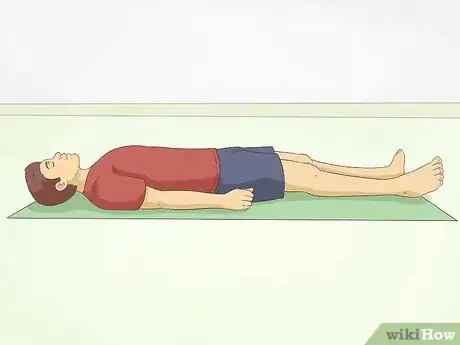
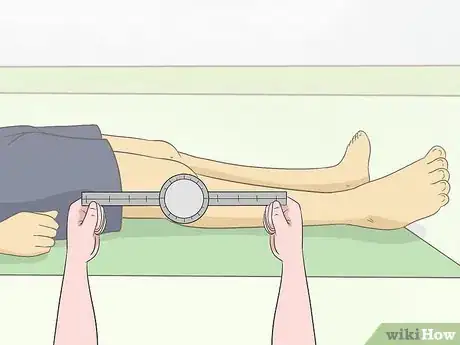
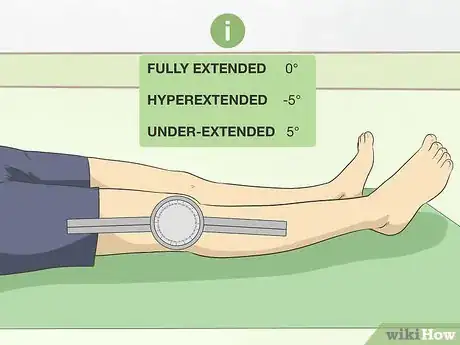
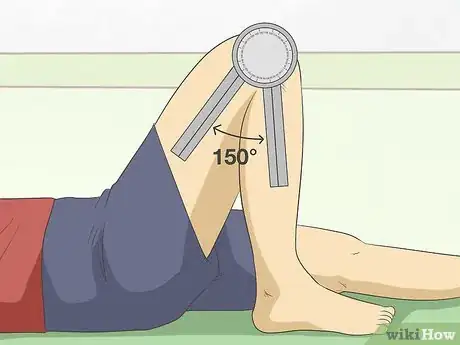
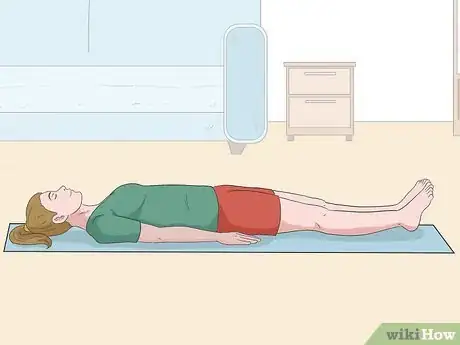

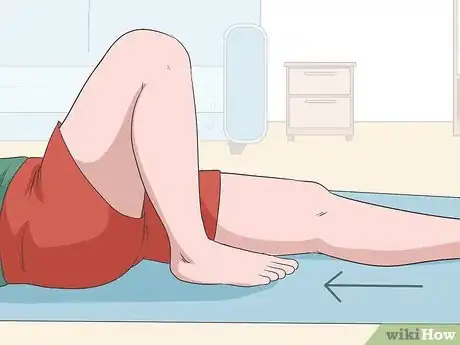
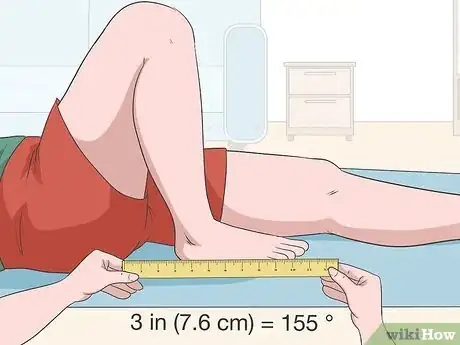

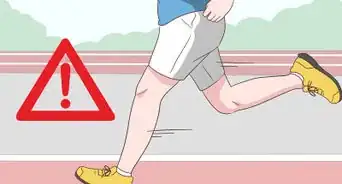
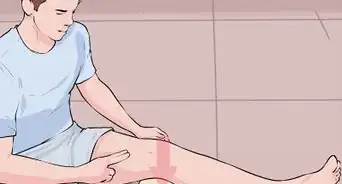




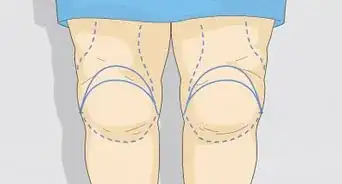


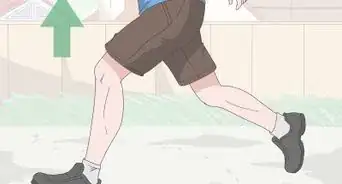















































Medical Disclaimer
The content of this article is not intended to be a substitute for professional medical advice, examination, diagnosis, or treatment. You should always contact your doctor or other qualified healthcare professional before starting, changing, or stopping any kind of health treatment.
Read More...